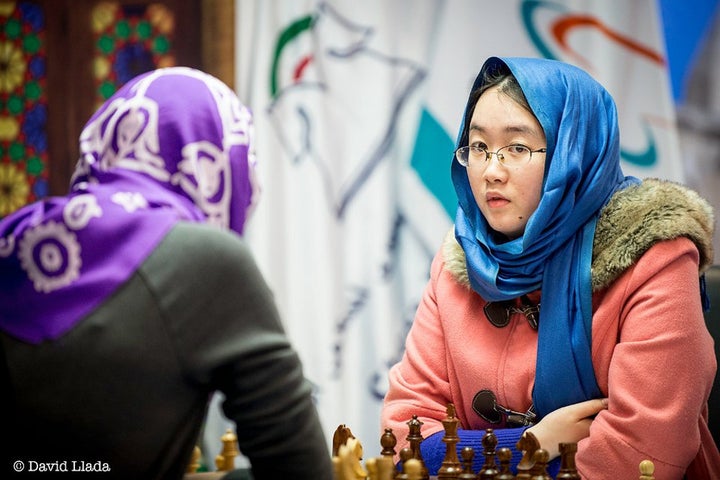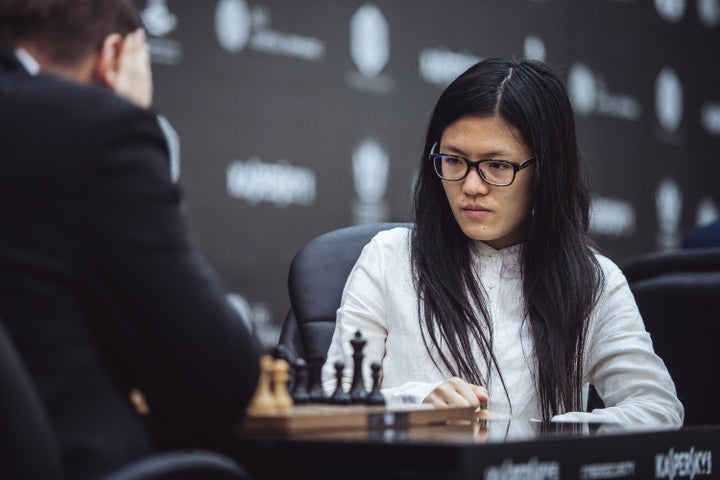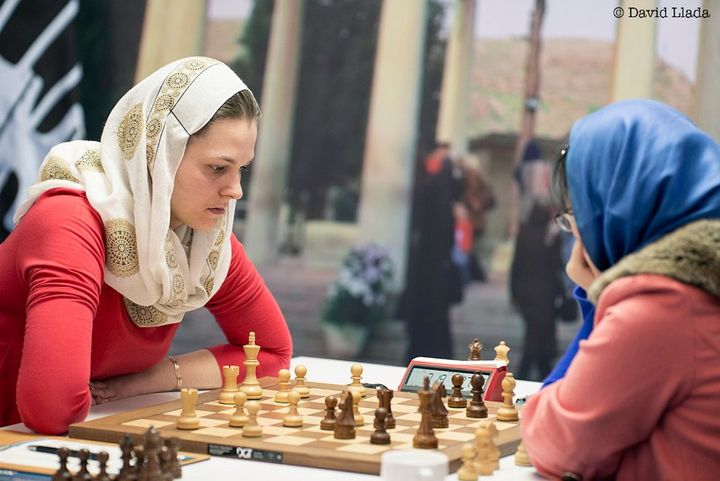Last week, Tan Zhongyi, a Chinese grandmaster, became the Women’s World Champion. She did it by winning a 64-player knockout tournament held in Tehran that included most of the world’s top players. For this triumph, Tan earned $48,000.
The tournament was exciting and there were some great games, particularly in the final, in which Tan beat Anna Muzychuk of Ukraine in a playoff. By all rights, it was a moment for women chess players to shine. Instead, the tournament and some of the problems surrounding its organization were a reminder that women chess players still trail their male colleagues in respect and prestige.

Tan Zhongyi during Game 1 of the final of the Women’s World Championship, which ended in a draw.
Some of the world’s top players boycotted the competition because of a requirement that all women in Iran, including the players, wear a headscarf. The most notable were Anna Muzychuk’s sister, Mariya, who is a former Women’s World Champion; Nazi Paikidze, the reigning United States Women’s Champion; Irina Krush, a seven-time U.S. Women’s Champion; and Carolina Lujan, an Argentinian international master. Humpy Koneru of India, currently ranked No. 4 in the world, and Tatiana Kosintseva and Alisa Galliamova of Russia, who are both in the top 30, also did not play, although they did not state their reasons publicly. A few others who received invitations also did not go.
The most significant omission was a compatriot of Tan’s -- Hou Yifan of China, the top-ranked woman in the world, who was the reigning titleholder before the tournament began. In an interview, Hou said that she did not play in protest of the format because it is not a good way to determine the world champion. She believes that only a long match, like the one that was played in New York City last November for the overall title, is the way to demonstrate who is the strongest player in the world. In a knockout tournament, she said, just one error can send a player home, but in a long match, players have a chance to recover.

Hou Yifan playing during the Grand Prix in Sharjah last month. She is the only woman in the Grand Prix for the overall title.
Indeed, while Tan is obviously a very strong player, she was the ninth seed in the tournament and is ranked No. 13 in the world. It is the second time in recent years that a player outside the top five has won the championship by winning a knockout tournament. In 2012, Anna Ushenina of Ukraine, who was the 30th seed, won the tournament. In that tournament, Hou was knocked out in the second round, but reclaimed the title by easily defeating Ushenina in a match in 2013. (Hou had earned the right to play for the title by winning the 2011-2012 Women’s Grand Prix.)
So why was the tournament held in Iran? And why has the World Chess Chess Federation, also known as FIDE, the game’s governing body, adopted a knockout format to sometimes decide the women’s champion?
The answers to both questions is apparently the same: sponsorship and money.
The Women’s World Championship tournament was actually supposed to be held last October, but there were no bidders. During last September’s Chess Olympiad in Baku, Azerbaijan, representatives of the Iranian Chess Federation offered to stage it in their country. One caveat was that Iran insisted that the women would have to observe local laws and play wearing the headscarves, a requirement that immediately brought protests from some players and others, including Emil Sutovsky, the president of the Association of Chess Professionals. FIDE ultimately accepted Iran’s offer, even after receiving a petition signed by more than 16,000 people protesting the decision. Perhaps FIDE felt it had no choice.

Anna Muzychuk, left, during Game 3 of the final of the Women’s World Championship, which she won with a brilliant attack.
FIDE officials have also said that the knockout format was adopted to try to make the women’s championship more exciting to sponsors, both by expanding the field of players competing for the title, and by making the result less predictable. It has certainly accomplished both goals, but it has also, as some players complain, “devalued” the title because the champion is not always the best player, or even close to it.
Ironically, in many ways, women’s chess is better off now than it has ever been. There are about two dozen women who have the full grandmaster title – far more than 20 years ago. Hou, who is 23, said that there are also many more opportunities for women now than when she learned the game in 2000, and she liked many changes in the world championship cycle, specifically citing the Grand Prix.
Nevertheless, she said that she will not play again in the women’s cycle until FIDE dispenses with knockout tournaments and only has matches decide the title. “I think it should be the same cycles as the men’s world championship,” she said. She suggested another possibility would be that FIDE keep the knockout tournament and perhaps have the winner of that play a match against the winner of the Grand Prix, with the winner then playing another match against the reigning champion.
“I talked with FIDE and I understand the problems,” Hou said. “But look at other sports. Most of them have the same system for selecting the champion for men and women.”
Until or unless FIDE changes its system, and finds a way to attract more sponsorship for its marque events for women, its champion will not be its best player and, it seems, women’s chess will continue to struggle.
-----------------------------------------------------
The final of the Women’s World Championship was a best-of-four matchup. After a draw in Game 1, Tan took the lead by winning Game 2.
Muzychuk struck back quickly with a brilliant attack in Game 3.
After the regulation part of the match ended in a tie, the match went to a two-game rapid playoff. Game 1 was drawn. Tan won Game 2 to clinch the title when Muzychuk walked into a mating net.